Photos: Kip Miller

Each summer multitudes of tourists from the British Isles and Northern Europe flock to Kos's magnificent sandy beaches.
Today the multitudes still descend upon Kos, but they come from farther
afield, abandoning the colder climes of the British Isles and Northern
Europe for the island's magnificent sandy beaches and historic sites,
and for a chance to island hop to neighboring Rhodes, Kalymnos and Nisyros,
or even Bodrum on the Turkish mainland. To accommodate its non-stop stream
of visitors, Kos has built one of the finest tourist infrastructures in
the entire Aegean. Lucky visitors who come to stay for a week or two are
rewarded with resorts and hotels for every budget, organized beaches,
bicycle paths, reliable bus service, an abundance of antiquities and medieval
castles, tours to neighboring islands, and tavernas and sweet shops offering
a wide range of local and international fare.
It's a midsummer's
day in 1987 and Athens is sweltering. We avoid the worst of the heat by
visiting a lineup of air-conditioned museums, but the weather is unrelenting.
"We need to escape to an island," my husband insists. At the
airline office on Syntagma Square, we zero in on Kos, part of the Dodecanese
chain, hoping to find a suitable hotel in spite of it being the peak of
the busy season. When it comes to Greece, our modus operandi has always
been to arrive without a definite itinerary and let our adventure develop
spontaneously, relying on the local tourist police to identify suitable
accommodations. But truth be told, I am feeling a bit anxious about finding
a hotel on this very popular island. "Not to worry," says my
optimistic husband. "We do it every time!" Our morning flight
is brief and soon we are taxiing on Kos's landing strip. I peer out the
window. It is a relatively flat island, save for the nearly 1000-foot
Mount Dikeos, a limestone and volcanic rock massif densely covered with
pines, its precipitous cliffs a sheer drop to the sea below. Half an hour
later, a taxi drops us in front of the tourist police in Kos town, the
island's historic capital built around an ancient harbor. "This place
sure has an Anatolian vibe," I comment as I gaze at lush palm trees
and spiky minarets juxtaposed against numerous classical ruins and Italianate
public buildings.
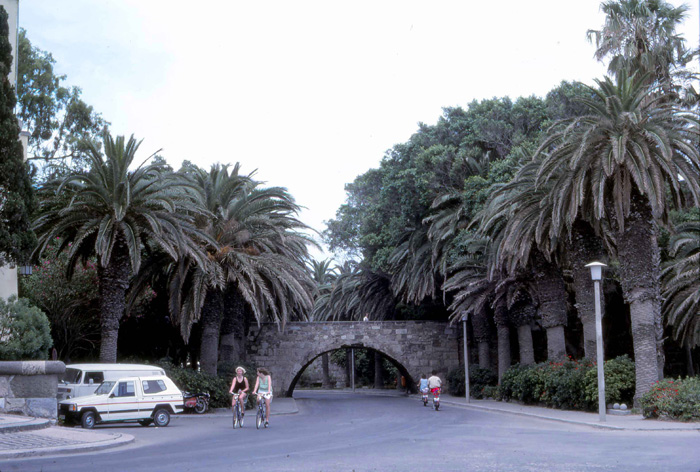
Kos has an Anatolian vibe, its luxuriant palms lining many streets in the capital.
"You're telling us that all the island hotels are full?" I blurt out, disappointed. "Yes, Madame, why did you not reserve ahead?" asks the overworked attendant at the tourist police. "Okay, I have an idea," he continues when he sees my face drop. "Stop at the following two hotels." He hands us a map that he has marked off. "I know the people there and they will try to help you for sure." At this point I am feeing extra grateful for his overture and that we have traveled light and can carry our bags without too much effort. The first hotel is fully booked and has no further ideas. At the second hotel, the cheerful matron at the desk comes up with a suggestion: "I just heard from my friend at the Poseidon Hotel, and they have a vacancy. It's on Makriyannis Street. You can walk there from here." She calls the hotel ahead to let them know we are coming. "So you are American!" comments the attendant behind the desk. "Bravo! You are the first ones I have seen at our hotel all summer," he breaks into a big smile. "Kalós orísate sto nisí mas (welcome to our island)!" I am thrilled to have found accommodations. "Efharistóume pára polí (thank you very much)," I respond. "Eínai makriá apo'dó to kéntro (Is the town center far from here)?" I ask in my best Greek. His jaw drops. "So you speak Greek!" "A little," I respond. From that moment on, we have a new best friend at the hotel who cannot do enough to be of help during our entire stay.
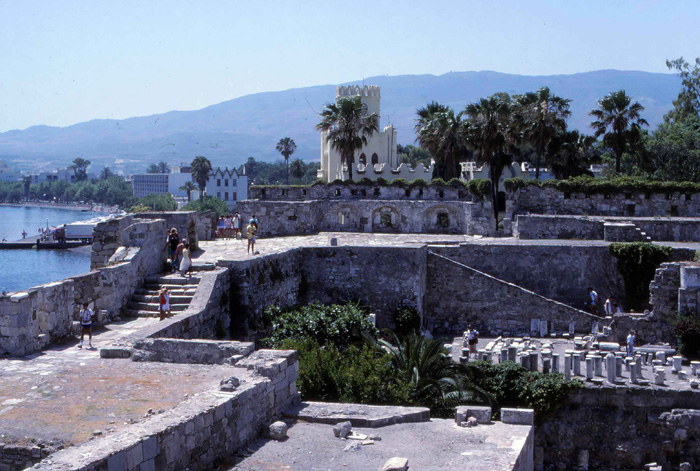
The massive ruined castle of Neratziá overlooks Kos's Mandráki (port), its ramparts looking out to Bodrum on the Turkish mainland.
Time is a continuum in Kos, and long-buried archaeological treasures crop
up each time a great quake shakes the ground, the last big one occurring
in 1933. There is much to see and we waste no time. In all directions,
antiquities in various stages of decay or restoration bear witness to
Kos's multi-layered history. The massive ruined castle of Neratziá
(the castle of sour oranges) is the perfect starting point for our exploration.
It abuts Kos's Mandráki (port) and is approached by a causeway
that crosses over an ancient moat, now filled with dirt and planted with
palms. The original castle of the Knights Hospitaller of St. John which
stood here from 1314-1450 was totally destroyed and replaced by the existing
inner castle. Thick outer walls surround it, built to withstand the advanced
artillery of Ottoman sieges in the late 15th and early 16th centuries.
Here and there architectural remnants of Kos's multi-layered past have
been incorporated into the old walls, from capitals and coats of arms
to escutcheons. "Let's walk on the ramparts" I suggest, enthralled
by the view. "Check out the enclosed harbor," says my husband,
marveling at the number of caïques and other small craft moored within.
Ancient Halicarnassus, today Turkey's Bodrum, is practically at our doorstep,
just a few kilometers across the channel. I stare back at the castle.
Scattered among the grounds are lines of broken columns plus dozens of
cannonballs, in situ where they fell centuries earlier.
We blend
into a group of Brits headed to the "Hippocrates" plane tree,
which according to local lore, the ancient physician planted himself.
Sixteen meters in circumference, its pendulous limbs are propped up on
steel scaffolding. "This tree cannot possibly date from 400 B.C.,"
says a woman next to me peering at the girth of the base, now split into
four sections. "You're right," I smile back at her, "it's
only about six or seven hundred years old, but it sure does make for a
nice local tradition." Adjoining the tree is the handsome Loggia
Mosque, built on the site of a former Byzantine church by the Ottoman
admiral who controlled Kos in the late 18th century. On its towering minaret
is a relief of a Nimean lion removed from a crumbling temple that was
dedicated to Hercules.
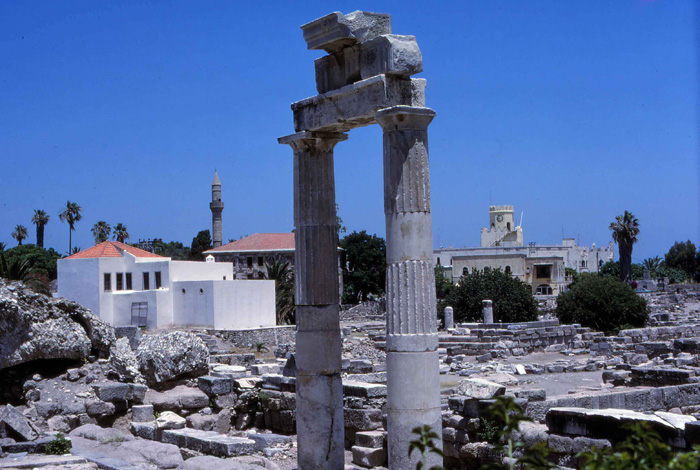
Kos's ancient agora is a jumble of Greek and Roman remains, including the ubiquitous Cardo and Decumanus dating from the 3rd century A.D.
Kos's agora is not far from the Hippocrates tree. It is a large site,
a veritable jumble of Greek and Roman remains, notably the foundation
of a massive temple to Aphrodite and a few columns from the old Roman
marketplace. Farther out, near an ancient acropolis, we spot two intersecting
marble-paved Roman roads, the ubiquitous Cardo and Decumanus, dating from
the third century A.D. Nearby are mosaic pavements depicting gladiators
and boar hunting. By now we have reached antiquities overload. "How
about if we follow this German tour group," I suggest. "Looks
like they're heading to the old Muslim quarter, the Haluvaziá."
The buildings here have seen better days, but with their colorful souvenir
shops, boutiques and hole-in-the-wall kebab joints they exude a shabby-chic
ambience. Alas, the only identifiable Ottoman remains we can spot are
a couple of dry fountains with Arabic writing.
"There once was a sizable Jewish community in Kos," I remind my husband. "Back in the time of the Maccabees, Kos town was already an important center of Jewish learning. Life was good until the 15th century, when Jews were all expelled by the controlling Knights of St. John. But when the Ottomans conquered the Dodecanese Islands, they were permitted to return." According to my guide book, a wealthy Koan Jew named Eliezer Tarsia built an elegant synagogue in the town. "However, like everything else, it was leveled by the great earthquake of 1933," I explain, "and later replaced by a new structure near the port." "What happened here during World War II?" asks my husband. "It's a tragic story," I sigh. "On July 22 1944, the Germans who had seized control of the Dodecanese Islands from the Italians, deported the entire Jewish community of Kos, along with more than 1000 Jews from Rhodes, first to Athens and then to Auschwitz-Birkenau. Out of over 100 Koan Jews, only one survived." We stroll toward Diakou Street to view the modernist synagogue building which now functions as a special events hall. The only other vestige of Jewish presence is near the Turkish hamlet of Platáni, a few kilometers from the capital. Here a small cemetery in a pine forest shields Hebrew gravestones, their dates stopping ominously after 1940.
Back at the seafront near Neratziá stands the Foro Italico, dating from the late 1920s and part of the sizable Italian footprint left on Kos after 31 years of occupation. The Italians, who by that time had turned Fascist, created a master plan for the rebuilding of most of the Dodecanese Islands in a unique style that fused Greek and Roman classical elements with the pointed arches of medieval structures. We pause in front of the Foro, once the Kos administration building, now serving as its police station. Nearby on Plateía Eleftheriás (Freedom Square) is Casa del Fascio (Fascist House) with its distinctive clock tower and speaker's balcony from which the government delivered its frequent incendiary speeches. "Imagine how enraged the Koans must have felt under the forced Italianization of their culture," I remark.
"Can you recommend a good place for dinner?" I query a maid in our hotel hallway. "Are you the one who speaks some Greek?" she asks with a smile. "Nai (yes)," I reply. "Who told you?" "O Yiannis sto grafeío (John at the desk)," she explains. "My name is Nefeli," she continues, "but please, I want to practice my English?" She introduces me to another maid exiting a room down the hall. "This is Toula. She wants to speak English too." How lucky are we! Over iced lemonades in the hotel's lounge, we share tidbits about our life in Philadelphia, our children, our work, how many times we have been to Greece and that we genuinely love the culture. Last of all, that I have been part of an adult Greek dance troupe, Theseus, for about seven years. "Sovará, dhen to pistévo! (Seriously, I don't believe it)," Toula interjects. They pepper us with questions, still not totally convinced that we are for real! "I have an idea," says Nefeli. "In a couple of days we will have some time off. I want to invite you to my house near Platáni so you can meet our families and then we will all go dancing together at a taverna nearby." "A great idea. We're on," we agree.
The sun is
sinking into the sea, its long rays streaked across the harbor. We head
out to a pint-sized eatery recommended by Nefeli. The owners hover over
us, bringing samples for us to try before we order. Everything, they inform
us, is made from their own family recipes. Over bowlfuls of avgolémono
soup followed by soutzoukákia -sauced meatballs -- we plan ahead
for the morning. "We could rent a car," says my husband, "but
I noticed that dune buggies are popular here. How about it? It will be
a fun way to get around," he convinces me.
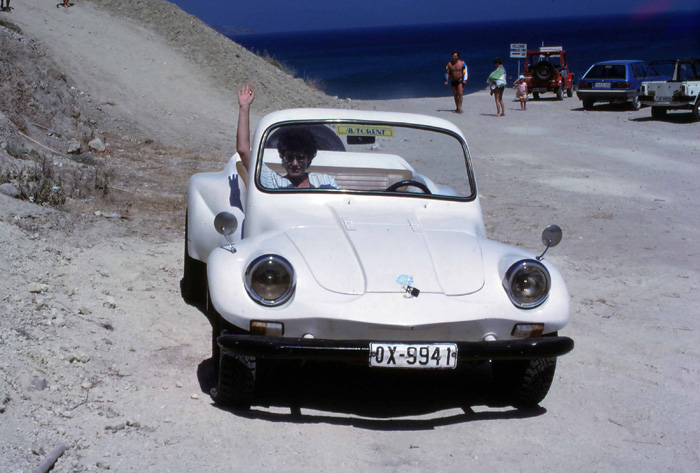
An open air dune buggy is the ideal way to immerse yourself in Kos's fields of wildflowers.
It's a perfect cloudless day. Ahead of us the limpid Aegean shifts across a spectrum of blue, its sand beaches bathed in the soft light of morning. Rows of beach umbrellas await the onslaught of tourists still at breakfast. We turn inland toward the Asclepeion, the island's number one attraction. It encompasses four levels amid a forest of cypresses, about 100 meters above the sea on the eastern slope of Mount Dikeos, a spectacular setting with views of the Kerameikós Gulf and Anatolia beyond. "I can appreciate why the ancients chose this location," I remark as we climb toward the center altar on the second level. The Asclepeion began as a single temple to the god Apollo but later evolved to a shrine to his son, Aesclepius. By the second century BC, the site had grown into a complex of terraces, stoas, temples, sanitariums, altars and a sacred grove, all linked by a monumental staircase. On the third terrace atop a new deck, the great temple of Asclepius was sited. "You are gazing at the birthplace of modern medicine," says my husband. "This is where Hippocrates taught and where the snake wrapped around a scepter became the symbol of the medical profession." Kos's native son lived for about ninety years and totally revolutionized the art of healing, abandoning millennia of belief that all illness was punishment inflicted by the gods, and thus unavoidable, in favor of new scientific methods based on clinical observation and application of specific treatments. To this very day physicians throughout the world take the Hippocratic Oath as they launch their careers. By the second half of the Hellenistic era, shrines to Asclepius sprang up throughout the ancient world, but only the ones at Epidaurus and Pergamum achieved the stature of Kos. Atop the last row of its monumental staircase, we sit in silence and survey the site, awed by the enormity of it all. "Hey, have look over there," my husband points toward the altar. About a dozen newly inducted Japanese physicians are ceremoniously taking the sacred oath as cameras click and a reporter speaks into a mike.
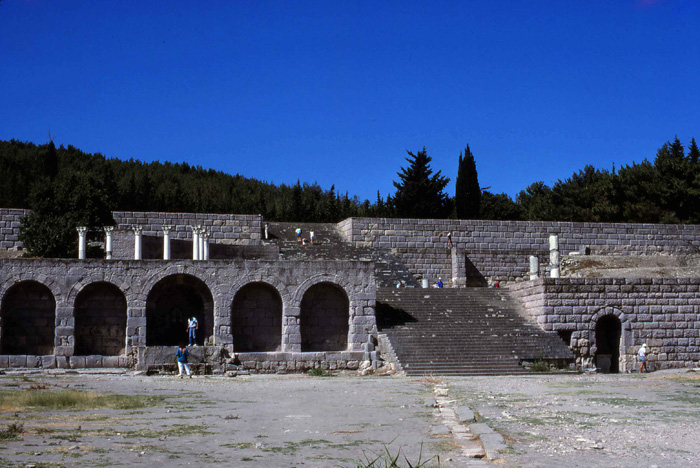
The Asclepion, Kos's premier attraction, is a sacred site dedicated to the ancient god of medicine, Asclepius. Here Hippocrates introduced new treatments and methods that revolutionized the art of healing.
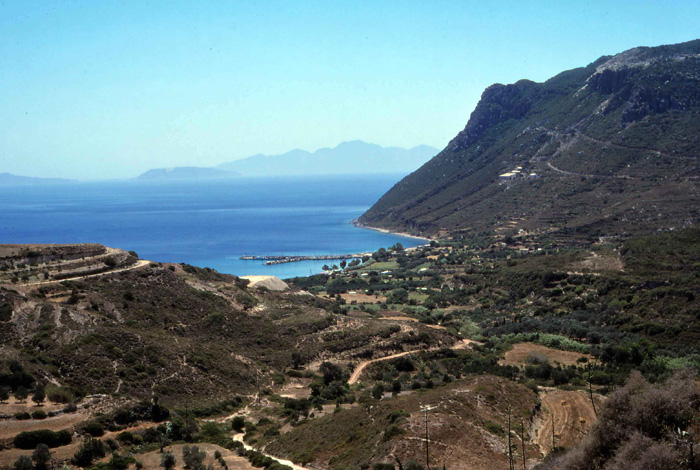
At the southwest tip of the island, the town of Kéfalos crowns a jagged coastline dotted with hidden coves.
Back on the coastal road, Kos's beaches are now swarming with bathers. At the southwest tip of the island the town of Kéfalos crowns a jagged coastline dotted with hidden coves. Not far from here lie the ruins of Astipálaia, once Kos's ancient capital and birthplace of Hippocrates. After several earthquakes demolished the site, the city was moved northeast to a natural bay around which the new capital rose. We smile back at a Scandinavian family posing in front of the town windmill. It is no longer operational, but makes for a great picture spot. Nearby several handicraft stalls beckon, but our passion for Greek ceramics draws us straight to a pottery workshop -- Vasso's. Her work is superior and I can tell by the glaze that a unique platter depicting a village scene will stand the test of time. Vasso triple wraps it in bubble wrap, delighted that we appreciate her work. "Where should we stop to eat?" we inquire. "Mou arései polí to Estiatório Argo (I really like Argo Restaurant)," she says without hesitation. We scan Argo's lineup of tables near the water's edge. "Let's grab the empty one over there!" we exclaim in unison. Our selection of grilled mullet, crispy fries and a side of hórta (steamed wild greens) is among our best ever meals in Greece.
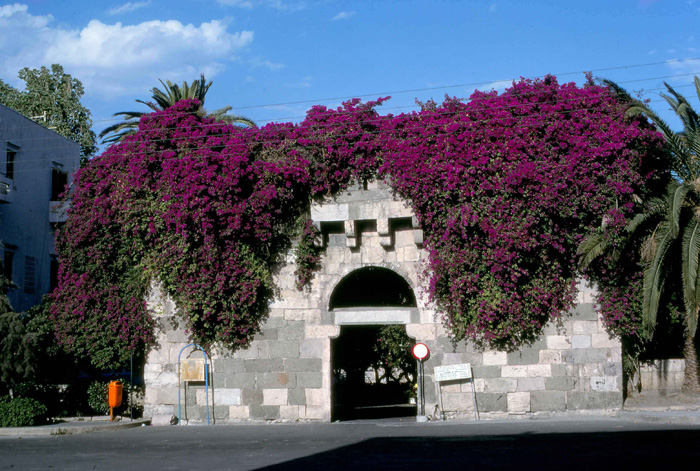
Old stone walls in Kos town are crowned with luxuriant mounds of bougainvillea.
Kos town is especially photogenic in the morning light. We stroll down streets lined with luxuriant palms, past mounds of bougainvillea atop stone walls, toward the famous archaeological museum on Eleftherias Square. It is chock full of marble sculptures, including several exemplary pieces from the Hellenistic era. A large statue of Artemis, virgin goddess of the hunt with a quiver of arrows on her back, takes my breath away. "Look at the little dog at her side," says my husband. "He must be her devoted pet!" In the museum peristyle, a pristine 2nd century AD mosaic floor depicts the arrival of Asclepius on the island. He is being received by a Koan as Hippocrates observes the scene from a nearby cave. "How fortunate that this particular mosaic survived all the earthquakes!" I exult.
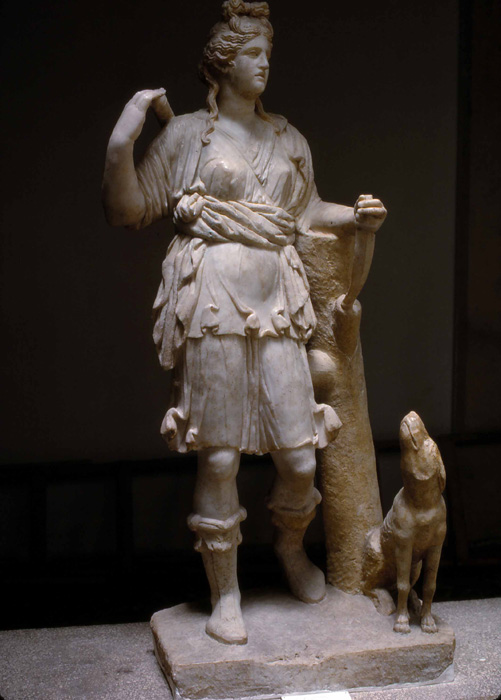
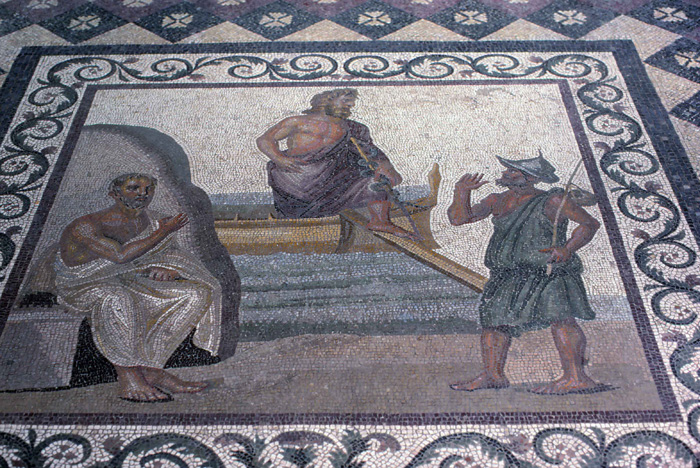
An evocative Hellenistic sculpture of Artemis, goddess of the hunt, and a Roman mosaic floor depicting the arrival of Asclepius are highlighted in Kos's archaeological museum.
East of the capital sprawls the rugged beach of Agios Fakas. The Aegean
is especially translucent here, revealing masses of shiny pebbles each
time the water ebbs. Behind the beach stretches a long row of eucalyptus
trees, reminding us that Kos is considered the "The Garden of the
Aegean." In addition its cypress and pine forests, many other species
thrive, especially myrtles, lentisks and pomegranates. We return to the
coastal road, then head inland. Our open-air dune buggy is a perfect way
to commune with nature, and we not only see, but also smell and touch
as we wind through fields carpeted with fennel, spearmint and sage. Many
of the local herbs and shrubs have medicinal properties. "No wonder
the Ascelpeion was built here!" I shout into the breeze.
Distances are short on Kos. At the beach town of Tingáki, we turn in the direction of Asfendioú. Minutes later we are ascending Mount Dikeos toward a cluster of small traditional villages. The rugged mountain is dotted with rushing streams and several abandoned quarries, undoubtedly the source of marble for its various ancient sites. Here and there historic churches peer out of the greenery, but the 16th century underground chapel of St. John Chostos requires on-foot exploration. We continue to Zia, a community nestled in a forest of pine and walnut trees and renowned for its dramatic views. It is the iconic Greek village of one's dreams -- whitewashed houses accented with blue shutters, cobbled streets, an old water mill, and mounds of flowers everywhere. Walking at leisure, we sample the local honey, sniff bags of herbs, and finger hand-made weavings. Zia once had a sizable population, but as job opportunities at Kos's beaches multiplied, its residents dwindled to about 200, for the time being still enough to service its crush of summer visitors. "Hey, are you hungry yet?" asks my husband, pointing toward a taverna with a large roof garden overlooking nearly all of Kos and its neighboring islands, including the Anatolian coast. "This view is absolutely incredible!" I gasp. Over a platter of flavorful stuffed tomatoes and peppers, we toast our host, Michalis, who is urging us to linger until evening. "The sunset here is like no other in Greece, polí ómorfi (very beautiful)," he boasts, twirling his right hand for emphasis. "OK, since you can't stay today, then you must come back tomorrow," he refuses to relent.
Tonight is our rendezvous with Nefeli and Toula and we rush back to town to freshen up. "What should we bring them?" I ask my husband. "I noticed a nice liquor store near the hotel. We could get them a fancy bottle of Scotch," he suggests. The desk provides us driving directions to Nefeli's house located in the outskirts of Platáni, Kos's only Turkish community. Out of several thousand Turks who opted to stay on the island after Greek Independence, only about 1,000 remain today. They lead quiet, industrious lives, adding snippets of Anatolian culture to the local mix. We drive past several Platáni restaurants, stopping to read their menu placards: Iskender Kebab, Imám Baïldi (braised eggplant) and Turkish Salads headline the lists. "I bet the food here is terrific," we both blurt out, remembering an amazing meal we had in Izmir years earlier.
"Kalós Orísate (welcome)," says Nefeli. Her entire family is gathered in the living room, along with Toula and her husband. All are eager to meet the Americans who love Greece and their dances. I look around the room which is comfortably furnished with an oversized couch and two reclining chairs. The TV is playing a dubbed version of "Jaws" and Nefeli's two young children erupt into ear-splitting shrieks each time the giant shark bares his menacing teeth. "Thank you so much for arranging this evening," I tell Nefeli, handing the bottle of Scotch to her husband. He seems a little taken aback and I am puzzled. "I should have told you what our family does for a living here in Kos," Nefeli explains. "We own a large liquor store on the outskirts of town." "Nothing like bringing coals to Newcastle," my husband mutters, feeling a little embarrassed. "But who knew!" Nefeli suppresses a chuckle. No doubt our blunder will be the highlight of their morning conversation. She gives us detailed directions to a popular taverna where she has made reservations.
Fifteen minutes
later our entire group is seated at a long table next to the dance floor.
An ensemble of five musicians are playing lively island melodies. "Let's
eat first, and then we'll dance," Nefeli suggests. We order family
style, sharing platters of mezédes (appetizers), mixed grill, mountains
of fries, and Greek salad heaped with local cherry tomatoes. "You
must try some krasótiri, our dessert goat cheese which is marinated
in red wine," Toula insists after we finish. It arrives with slices
of watermelon to bring out its delicious nutty flavor. The musicians break
into a syrtós dance popular on Kos and Rhodes. "It looks almost
Cretan," I remark. "You are right. Some of our local dances
were brought here when many Cretans settled on Kos earlier in the century,"
Nefeli explains. The ladies all head to the dance floor and I join in,
feeling totally at home. We whirl around for a good ten minutes. The musicians
switch to a fast, syncopated soústa and I do my best to keep up.
"Bravo, bravo," they cheer me on. We dance intermittently for
another hour, impressed by the enormous repertoire of the musicians. "Óla
ta xéroun (they know everything)," Toula brags. "Did
you say you are making a day trip to Kalymnos tomorrow?" Nefeli asks
as we hug in parting. "Yes, we leave from Mastihári,"
my husband responds. "Then you should drive to Antimachía
when you return," she insists. "It's not far and it has a fantastic
castle!"
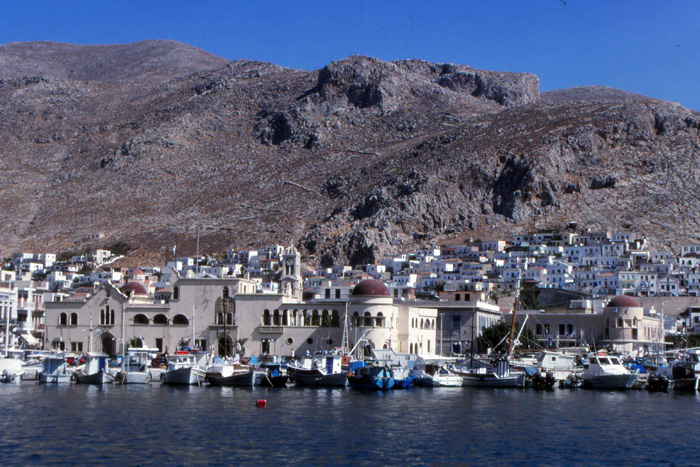
Pothia's expansive waterfront is framed by rugged limestone peaks. The island attracts sport rock climbers from all over the world who are challenged by its vertical peaks.
The sea is calm. Our morning tour boat sets out toward Kalymnos and I
am filled with great anticipation. Soon enough the lively harbor town
of Póthia stretches before us, framed by lofty limestone crags.
This non-touristy island exudes an air of prosperity, its lively waterfront
curving around a deep bay. When pirate attacks abated in the in the middle
of the 19th century, many wealthy island families relocated to the harbor
area and tiers of elegant neoclassical houses are testimony to the immense
prosperity they amassed from centuries of sponge diving. The majority
of visitors to the island are Greek-Americans of Kalymnian descent or
European rock climbers who come to scale its rugged cliffs. "Be back
here by three in the afternoon," the captain announces as we disembark.
"You have about four hours to explore Kalymnos."
We stroll at leisure along the waterfront, past Póthia's enormous town hall where Italian occupiers once had their headquarters, alongside the town's Transfiguration Cathedral known for its evocative frescoes, toward several shops with overflowing bins of sponges. Tantalizing scents waft out of a tiny sweet shop and we stop to sample their house-made galaktoboúreko, a crunchy filo pastry filled with semolina custard, doubly delicious with tiny cups of Greek coffee. We continue to the Vouvális Museum, a three-story neoclassic mansion once owned by the wealthiest sponge merchant on the island. Its handsome rooms typify the formal lifestyle of the island's upper class down to the last detail. "If we grab a taxi now, we'll have just enough time to explore Vathýs," I suggest. This narrow inlet, only a short ride from Póthia, is known as "the fjord of Greece," its turquoise waters snaking through a barren landscape that terminates at Rina, a pint-sized port with a shipyard and several competing tavernas. Beyond the port stretches a lush, fertile valley enclosed in stone walls where orange and tangerine orchards yield exceptional fruit. We grab a table at Porto Vathýs and share a platter of kalamária accompanied by icy Mythos beers, the perfect lunch in this maritime setting.
"So where is our captain?" asks my husband as we join a long line of passengers waiting to return to Kos. An hour passes by, but he is nowhere to be seen. "Greek time," I grumble under my breath. Suddenly, we spot him running to the boat, flushed and tucking his shirt into his pants. "Lipámai (I'm sorry)," he apologizes repeatedly. "Xéhasa tin óra (I forgot the time)." And then it dawns on me. Our captain obviously has a girlfriend in Kalymnos, and he must have fallen into a deep slumber after their afternoon delight! The passengers suppress their chuckles and climb on board. As we pull out of the harbor, we shift our focus back to Kos. "Shall we drive up to Antimachía after we arrive?" I ask. "Nefeli said it's worth seeing."
The massive
medieval fortress crowns a hilltop near the town of Antimachía,
part of the impressive line of defenses built by the Knights Hospitaller
of St. John that included the Neratziá and a ruined castle in Pyli
on Mt. Dikeos. At one time it even served as a prison for knights "who
had behaved badly." Built of volcanic boulders, it has a triangular
shape and follows the contours of the land. We pass under the cartouche
over its second set of double doors bearing the coat of arms of the Grand
Master d'Aubusson. According to my guidebook "Antimachía withstood
frequent attacks by Algerian and Saracen corsairs. Such were its remarkable
defenses that in 1451 some 200 brave townspeople and 15 knights held out
for 20 days against an Ottoman siege of 10,000 soldiers." "That
is amazing!" remarks my husband. Later that evening we head out for
a final stroll past the twinkling Mandráki. Kos sure was one forward-thinking
place, I muse as the sun plunges into the sea. The ancients here understood
nature, came up with innovative solutions to difficult problems, and embraced
a world of limitless possibilities. For sure the modern Koans inherited
those genes, I decide.
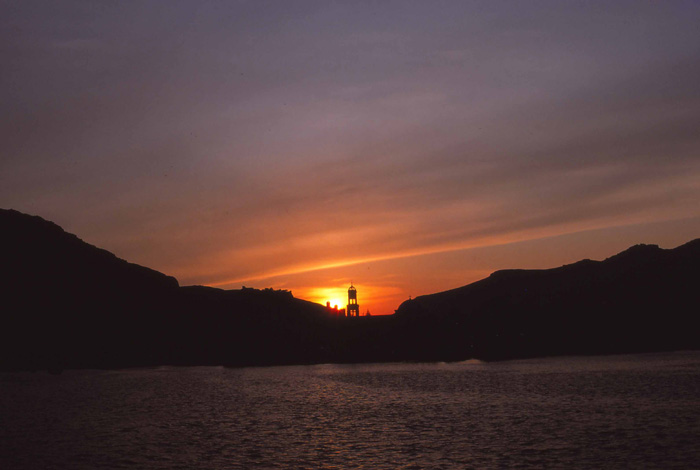
The plunging sun is a nightly spectacle in the capital whose modern descendants proudly exemplify the island's intellectual legacy
